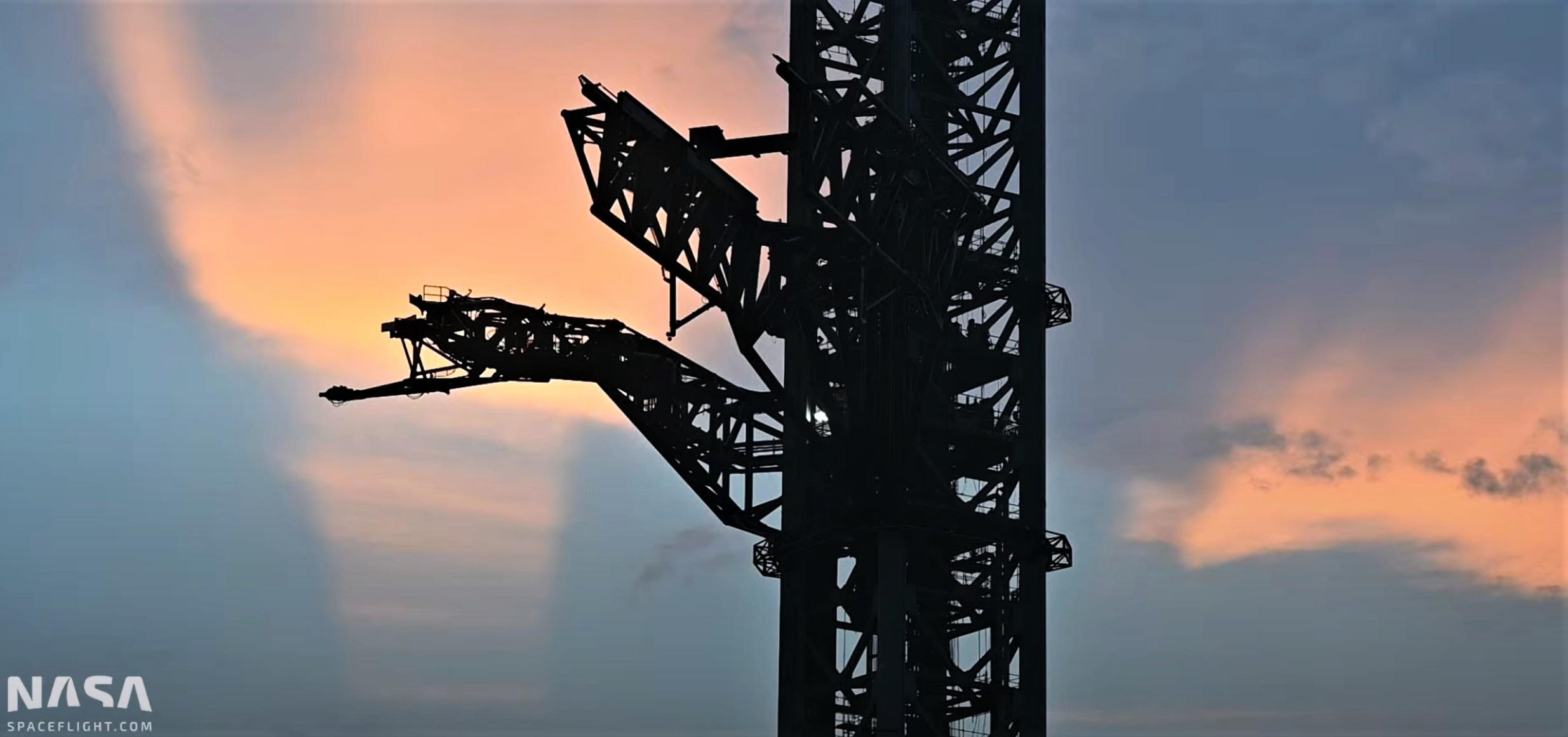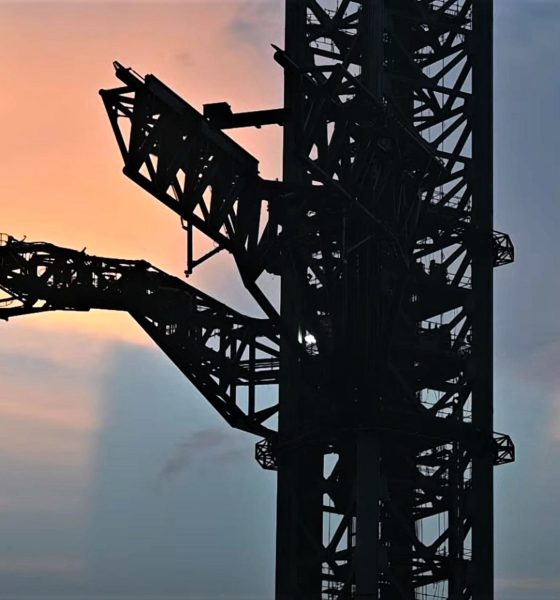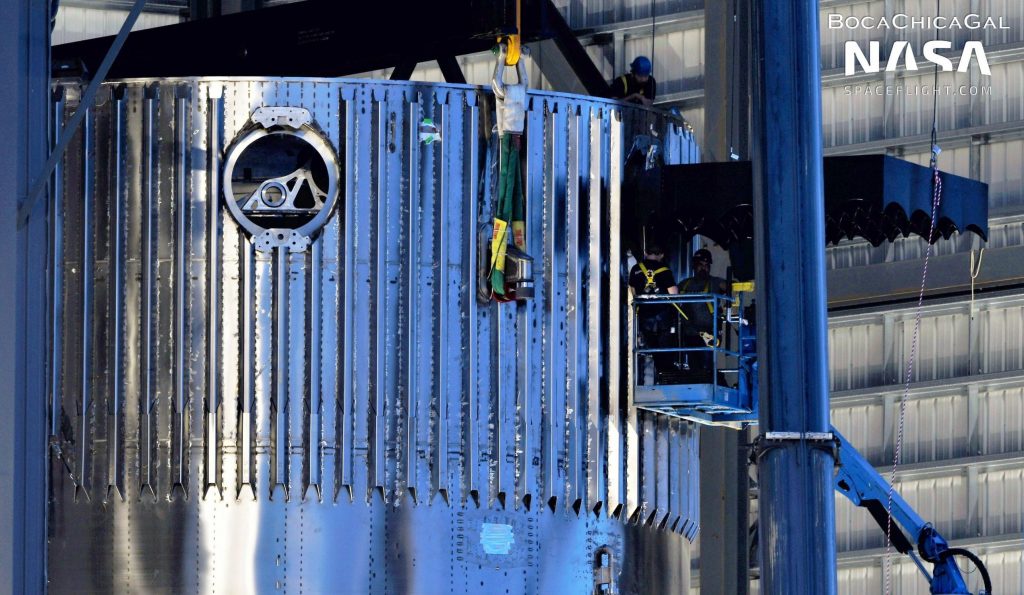

News
SpaceX simulates lifting Starship with launch tower ‘arms’
SpaceX has taken Starbase’s rocket-catching launch tower ‘arms’ to new heights during the latest series of proof tests.
That process began in earnest on January 4th, when SpaceX lifted, opened, and swung the tower’s building-sized arms for the first time. Four days later, SpaceX performed a variation on the first round of tests, again slowly lifting the assembly up the side of the launch tower and opening and closing the arms. The most notable difference was the addition of several tandem swing tests, which hinted at more applied tests that were soon to come. SpaceX also performed some basic tests with a third Starship fueling arm higher up on the tower, very slowly swinging it towards where Starship would be standing.
On Sunday afternoon, a third major round of testing kicked off. This set of tests was considerably more focused than the prior two, suggesting that it was more of a simulation of the main purpose of the arms.
Instead of lifting a few dozen feet and performing basic actuation and coordination tests, SpaceX simply lifted the arm assembly up along the tower’s exterior and didn’t stop. There were a few temporary pauses but the arms ultimately reached the approximate height they’d need to reach to stack a Starship on top of a Super Heavy booster. In fact, despite being (in)famous for being partially designed to catch boosters and ships out of mid-air, the main purpose of the arms – and likely the only reason they exist at all – is to safely, accurately, and precisely lift, install, and stack Starships and Super Heavy boosters.
SpaceX could obviously use a giant crawler or tower crane to accomplish a similar feat but cranes – especially large and tall ones – are extremely sensitive to wind conditions and effectively become very unsafe to operate in anything more than a brisk breeze. To put it lightly, even the average weather on the South Texas Gulf Coast is anything but conducive to the routine and reliable operation of giant cranes, which is exactly what SpaceX would need to avoid near-future Starship launch and recovery operations being constantly delayed by weather.

On January 9th, SpaceX appeared to test exactly that function. Before the day’s testing began, workers installed a large steel bar believed to be a weight simulator between the arms. Just like a booster would, the simulator sat – one end resting on both arms – on two small steel appendages identical to those present on all recent Super Heavy prototypes. On top of serving as a hardpoint for cranes, the downward-facing end of the L-shaped structures are capped with a small steel tip designed to take the whole weight of a Super Heavy. Those two minuscule steel caps – each no more than a foot wide – are what SpaceX (or at least CEO Elon Musk) wants Super Heavy to ‘land’ on to be “caught” by the launch tower’s arms.
More importantly, those caps – covering heavy-duty bearings – are also what the arms will ‘grab’ and manipulate to carefully position Super Heavy boosters for launch mount installation. To do so, each arm has a pair of parallel screw rods that can move together to shift the booster closer to or further away from the launch tower or move in opposite directions to slightly rotate it.
Once the arms reached the top of the tower, SpaceX performed several swing tests, mirroring the kind of movements they would use to carefully lift Starship, swing it over top of Super Heavy, and mate the two stages. Ultimately, the tower seemed to complete the simulation without any showstopping issues. Up next, it’s possible that SpaceX will add weights to the simulator bar to fully simulate the 100-200 ton masses of Starship and Super Heavy. Eventually, SpaceX may also use Starship S20 and Super Heavy B4 to fully qualify the arms by actually lifting, stacking, and removing both stages.

Elon Musk
Elon Musk and Tesla AI Director share insights after empty driver seat Robotaxi rides
The executives’ unoccupied tests hint at the rapid progress of Tesla’s unsupervised Robotaxi efforts.

Tesla CEO Elon Musk and AI Director Ashok Elluswamy celebrated Christmas Eve by sharing personal experiences with Robotaxi vehicles that had no safety monitor or occupant in the driver’s seat. Musk described the system’s “perfect driving” around Austin, while Elluswamy posted video from the back seat, calling it “an amazing experience.”
The executives’ unoccupied tests hint at the rapid progress of Tesla’s unsupervised Robotaxi efforts.
Elon and Ashok’s firsthand Robotaxi insights
Prior to Musk and the Tesla AI Director’s posts, sightings of unmanned Teslas navigating public roads were widely shared on social media. One such vehicle was spotted in Austin, Texas, which Elon Musk acknowleged by stating that “Testing is underway with no occupants in the car.”
Based on his Christmas Eve post, Musk seemed to have tested an unmanned Tesla himself. “A Tesla with no safety monitor in the car and me sitting in the passenger seat took me all around Austin on Sunday with perfect driving,” Musk wrote in his post.
Elluswamy responded with a 2-minute video showing himself in the rear of an unmanned Tesla. The video featured the vehicle’s empty front seats, as well as its smooth handling through real-world traffic. He captioned his video with the words, “It’s an amazing experience!”
Towards Unsupervised operations
During an xAI Hackathon earlier this month, Elon Musk mentioned that Tesla owed be removing Safety Monitors from its Robotaxis in Austin in just three weeks. “Unsupervised is pretty much solved at this point. So there will be Tesla Robotaxis operating in Austin with no one in them. Not even anyone in the passenger seat in about three weeks,” he said. Musk echoed similar estimates at the 2025 Annual Shareholder Meeting and the Q3 2025 earnings call.
Considering the insights that were posted Musk and Elluswamy, it does appear that Tesla is working hard towards operating its Robotaxis with no safety monitors. This is quite impressive considering that the service was launched just earlier this year.
Elon Musk
Starlink passes 9 million active customers just weeks after hitting 8 million
The milestone highlights the accelerating growth of Starlink, which has now been adding over 20,000 new users per day.

SpaceX’s Starlink satellite internet service has continued its rapid global expansion, surpassing 9 million active customers just weeks after crossing the 8 million mark.
The milestone highlights the accelerating growth of Starlink, which has now been adding over 20,000 new users per day.
9 million customers
In a post on X, SpaceX stated that Starlink now serves over 9 million active users across 155 countries, territories, and markets. The company reached 8 million customers in early November, meaning it added roughly 1 million subscribers in under seven weeks, or about 21,275 new users on average per day.
“Starlink is connecting more than 9M active customers with high-speed internet across 155 countries, territories, and many other markets,” Starlink wrote in a post on its official X account. SpaceX President Gwynne Shotwell also celebrated the milestone on X. “A huge thank you to all of our customers and congrats to the Starlink team for such an incredible product,” she wrote.
That growth rate reflects both rising demand for broadband in underserved regions and Starlink’s expanding satellite constellation, which now includes more than 9,000 low-Earth-orbit satellites designed to deliver high-speed, low-latency internet worldwide.
Starlink’s momentum
Starlink’s momentum has been building up. SpaceX reported 4.6 million Starlink customers in December 2024, followed by 7 million by August 2025, and 8 million customers in November. Independent data also suggests Starlink usage is rising sharply, with Cloudflare reporting that global web traffic from Starlink users more than doubled in 2025, as noted in an Insider report.
Starlink’s momentum is increasingly tied to SpaceX’s broader financial outlook. Elon Musk has said the satellite network is “by far” the company’s largest revenue driver, and reports suggest SpaceX may be positioning itself for an initial public offering as soon as next year, with valuations estimated as high as $1.5 trillion. Musk has also suggested in the past that Starlink could have its own IPO in the future.
News
NVIDIA Director of Robotics: Tesla FSD v14 is the first AI to pass the “Physical Turing Test”
After testing FSD v14, Fan stated that his experience with FSD felt magical at first, but it soon started to feel like a routine.

NVIDIA Director of Robotics Jim Fan has praised Tesla’s Full Self-Driving (Supervised) v14 as the first AI to pass what he described as a “Physical Turing Test.”
After testing FSD v14, Fan stated that his experience with FSD felt magical at first, but it soon started to feel like a routine. And just like smartphones today, removing it now would “actively hurt.”
Jim Fan’s hands-on FSD v14 impressions
Fan, a leading researcher in embodied AI who is currently solving Physical AI at NVIDIA and spearheading the company’s Project GR00T initiative, noted that he actually was late to the Tesla game. He was, however, one of the first to try out FSD v14.
“I was very late to own a Tesla but among the earliest to try out FSD v14. It’s perhaps the first time I experience an AI that passes the Physical Turing Test: after a long day at work, you press a button, lay back, and couldn’t tell if a neural net or a human drove you home,” Fan wrote in a post on X.
Fan added: “Despite knowing exactly how robot learning works, I still find it magical watching the steering wheel turn by itself. First it feels surreal, next it becomes routine. Then, like the smartphone, taking it away actively hurts. This is how humanity gets rewired and glued to god-like technologies.”
The Physical Turing Test
The original Turing Test was conceived by Alan Turing in 1950, and it was aimed at determining if a machine could exhibit behavior that is equivalent to or indistinguishable from a human. By focusing on text-based conversations, the original Turing Test set a high bar for natural language processing and machine learning.
This test has been passed by today’s large language models. However, the capability to converse in a humanlike manner is a completely different challenge from performing real-world problem-solving or physical interactions. Thus, Fan introduced the Physical Turing Test, which challenges AI systems to demonstrate intelligence through physical actions.
Based on Fan’s comments, Tesla has demonstrated these intelligent physical actions with FSD v14. Elon Musk agreed with the NVIDIA executive, stating in a post on X that with FSD v14, “you can sense the sentience maturing.” Musk also praised Tesla AI, calling it the best “real-world AI” today.








